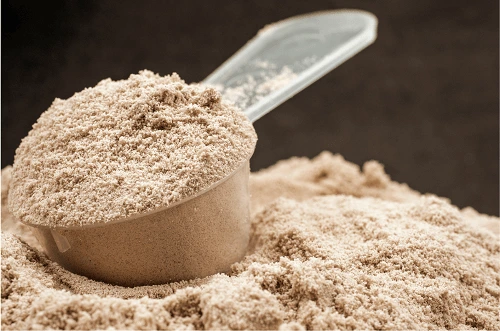Breakfast
How to Make Protein Powder at Home
How to Make Protein Powder
Protein powder is a popular nutritional supplement used by fitness enthusiasts, athletes, and individuals seeking to increase their protein intake. While there are numerous protein powders available in the market, making your own at home allows you to have control over the ingredients and tailor it to your specific dietary needs. In this article, we will guide you through the process of making protein powder at home, ensuring that you have a high-quality and cost-effective alternative to store-bought options.
1. Introduction
It is a convenient way to supplement your diet with high-quality protein. It is commonly used by individuals looking to build muscle, recover from intense workouts, or simply add more protein to their meals. While there are numerous brands and flavors available in the market, making your own protein powder allows you to have complete control over the ingredients and avoid any additives or artificial flavors.
2. Why Make Protein Powder at Home?
There are several reasons why making it at home is advantageous. Firstly, it gives you the flexibility to choose the protein source based on your dietary preferences and needs. Additionally, store-bought protein powders can be expensive, and making your own can save you money in the long run. Moreover, homemade protein powder allows you to avoid any unnecessary additives, preservatives, or artificial sweeteners that are often present in commercial products.
3. Choosing the Right Protein Source
The first step in making your own protein powder is selecting the right protein source. There are various options available, such as whey, casein, soy, pea, hemp, or rice protein. Consider factors such as taste, allergens, and dietary restrictions when choosing your protein source. Each protein type has its own unique characteristics, so select the one that best aligns with your goals and preferences.
4. Ingredients to Make the Protein Powder
To make your homemade protein powder, you will need the following ingredients:
- Protein source (e.g., whey, casein, soy, pea, hemp, rice protein)
- Optional flavorings (e.g., cocoa powder, vanilla extract, spices)
- Sweeteners (e.g., stevia, honey, maple syrup)
- Optional additions (e.g., chia seeds, flaxseeds, almond flour)
Make sure to gather all the ingredients before you start the preparation process. It is important to ensure that the ingredients are of high quality and free from any contaminants for the best results.
5. Equipment Needed
In addition to the ingredients, you will require the following equipment:
- Blender or food processor
- Measuring cups and spoons
- Airtight container or jar for storage
- Sieve (optional, for achieving a smoother texture)
- Funnel (for transferring the powder to the storage container)
Having the necessary equipment ready will make the process smoother and more efficient.
6. Step-by-Step Instructions
Step 1: Selecting Your Protein Source
Start by choosing your preferred protein source. Consider factors such as taste, nutritional content, and dietary restrictions when making your selection. You can opt for single-source proteins or create a blend of different protein types to achieve a desired balance.
Step 2: Preparing the Ingredients
Ensure that all the ingredients are clean and free from any impurities. If necessary, wash and dry them thoroughly. Depending on the protein source chosen, you may need to grind certain ingredients into a fine powder.
Step 3: Grinding and Blending
Using a high-quality blender or food processor, grind the ingredients until they reach a fine, powdery consistency. For a smoother texture, you can pass the powder through a sieve to remove any coarse particles. Be patient during this process to achieve the desired consistency.
Step 4: Storing Your Protein Powder
Transfer the homemade protein powder to an airtight container or jar. Store it in a cool, dry place away from direct sunlight. Proper storage will help maintain its freshness and extend its shelf life.
7. Tips for Customizing Your Protein Powder
Here are some tips to customize your homemade protein powder:
- Flavor it up: Add natural flavors like cocoa powder, vanilla extract, or spices such as cinnamon or nutmeg to enhance the taste of your protein powder.
- Sweeten to taste: Use natural sweeteners like stevia, honey, or maple syrup to add a touch of sweetness to your protein powder. Adjust the amount based on your preference.
- Boost with superfoods: Incorporate additional ingredients like chia seeds, flaxseeds, or almond flour for added nutritional benefits and texture variation.
- Play with spices: Experiment with different spices like ginger, cardamom, or turmeric to give your protein powder a unique flavor profile.
- Consider fruit powders: If you enjoy fruity flavors, consider adding fruit powders such as strawberry, blueberry, or banana powder to infuse your protein powder with a burst of natural fruit flavor.
- Mix protein sources: Combine different protein sources, such as blending whey and casein proteins or using a plant-based protein blend, to create a protein powder with a well-rounded amino acid profile.
- Adjust consistency: If you prefer a thicker or thinner protein powder, you can modify the consistency by adding ingredients like oats or coconut flour for thickness or almond flour for a lighter texture.
- Experiment gradually: When customizing your protein powder, start with small quantities of additional ingredients and gradually adjust according to your taste preferences.
Remember to keep track of the amounts and ratios of the ingredients you use to achieve the desired taste and nutritional composition of your personalized protein powder. Enjoy the process of creating a protein powder that is tailored to your liking!
Experiment with different flavors, sweeteners, or additional ingredients to create a personalized protein powder that suits your taste and nutritional requirements.
8. Benefits of Homemade Protein Powder
There are several benefits of making your own protein powder:
- Ingredient control: By making your protein powder at home, you have full control over the ingredients used. You can choose high-quality protein sources, avoid unnecessary additives, and ensure that no artificial flavors or sweeteners are included.
- Avoid additives and allergens: Many commercial protein powders contain additives, preservatives, and potential allergens. Making your own protein powder allows you to eliminate these additives and customize the blend to suit your dietary needs and restrictions.
- Cost-effective: Homemade protein powder can be more cost-effective in the long run. Buying protein powder in bulk and making your own blend can save you money compared to purchasing pre-packaged options.
- Personalized blend: Creating your own protein powder allows you to tailor the blend to your specific needs and preferences. You can adjust the protein source, flavor, sweetness, and texture to create a personalized blend that suits your taste and nutritional requirements.
- Freshness and quality: When you make protein powder at home, you can ensure its freshness and quality. By using fresh ingredients and storing it properly, you can enjoy a protein powder that is at its peak in terms of taste and nutritional value.
- Customizable nutritional profile: Making your own protein powder enables you to customize the nutritional profile according to your goals. You can adjust the protein content, carbohydrate and fat levels, and incorporate additional ingredients for specific nutritional benefits.
- Greater transparency: By making your own protein powder, you have transparency regarding the sourcing and quality of the ingredients. You can choose organic, non-GMO, or sustainably sourced ingredients, providing peace of mind about what you are consuming.
- Satisfaction and creativity: Making your own protein powder can be a fulfilling and creative process. It allows you to experiment with flavors, textures, and ingredient combinations, resulting in a unique blend that you can take pride in.
By making your own protein powder at home, you can enjoy these benefits and have a protein supplement that is tailored to your preferences, dietary needs, and budget.
9. Safety Precautions
While making it at home is generally safe, it’s important to follow these safety precautions:
- Cleanliness: Ensure that all the equipment, utensils, and containers used in the process are clean and free from any contaminants. Wash them thoroughly before use.
- Quality ingredients: Use high-quality ingredients to make your protein powder. Choose fresh protein sources and ensure that all other ingredients are free from mold, pests, or spoilage.
- Storage: Store your homemade protein powder in a clean, airtight container in a cool, dry place away from direct sunlight. This helps maintain its freshness and prevents moisture absorption.
- Hygiene: Follow good hygiene practices while handling the ingredients and equipment. Wash your hands thoroughly before starting the preparation process to minimize the risk of contamination.
- Allergies and sensitivities: Be mindful of any allergies or sensitivities you or others may have to certain ingredients. If you or anyone consuming the protein powder has allergies, avoid using ingredients that may trigger an allergic reaction.
- Labeling: Clearly label the container with the date of preparation and the ingredients used. This helps you keep track of the freshness of the powder and enables others to be aware of its contents.
- Consumption timeframe: Although homemade protein powder can have a good shelf life, it is recommended to consume it within a reasonable timeframe to ensure its freshness and nutritional value. Discard any powder that shows signs of spoilage or has passed its expiration date.
- Consultation: If you have any specific health concerns or conditions, it’s advisable to consult with a healthcare professional or a registered dietitian before making and consuming homemade protein powder.
By following these safety precautions, you can ensure that your homemade protein powder is safe for consumption and maintains its quality over time.
Adhere to proper food safety practices to ensure that your homemade protein powder is safe for consumption.
10. Conclusion
Making it at home is a rewarding and cost-effective alternative to store-bought options. By following the step-by-step instructions provided in this article, you can create a high-quality, customized protein powder that aligns with your dietary needs and preferences. Enjoy the benefits of homemade protein powder and take control of your nutrition.
Frequently Asked Questions (FAQs)
1: Can I use multiple protein sources to create my homemade protein powder? Yes, you can blend different protein sources to achieve a desired balance and enhance the nutritional profile of your protein powder.
2: How long does homemade protein powder last? When stored properly in an airtight container, homemade protein powder can last for several months. However, it’s recommended to consume it within a reasonable timeframe to ensure freshness and optimal quality.
3: Can I flavor my homemade protein powder? Absolutely! You can add natural flavors like cocoa powder, vanilla extract, or spices to enhance the taste of your protein powder.
4: Is homemade protein powder suitable for vegans? Yes, you can choose plant-based protein sources like soy, pea, hemp, or rice protein to create a vegan-friendly homemade protein powder.
5: Can I use homemade protein powder in recipes other than shakes? Certainly! Homemade protein powder can be added to various recipes, including smoothies, baked goods, energy bars, and protein balls, to increase their protein content.

